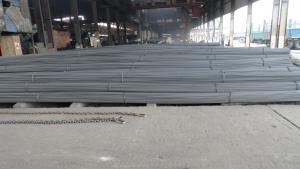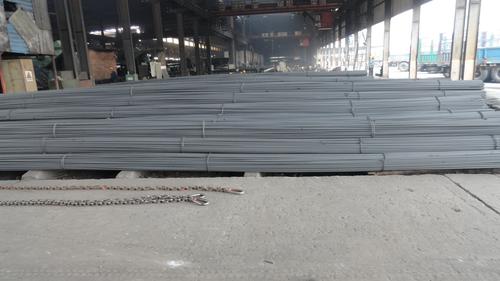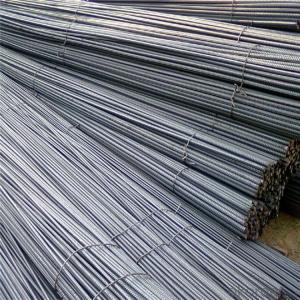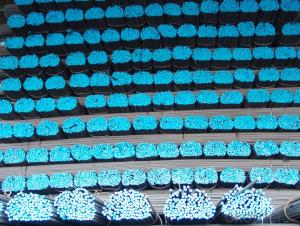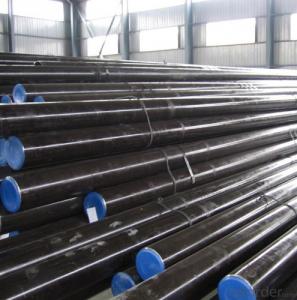Hot Rolled Reinforcing Steel Bar
- Loading Port:
- China Main Port
- Payment Terms:
- TT or LC
- Min Order Qty:
- -
- Supply Capability:
- -
OKorder Service Pledge
OKorder Financial Service
You Might Also Like
Product Description:
OKorder is offering Hot Rolled Reinforcing Steel Bar at great prices with worldwide shipping. Our supplier is a world-class manufacturer of steel, with our products utilized the world over. OKorder annually supplies products to African, South American and Asian markets. We provide quotations within 24 hours of receiving an inquiry and guarantee competitive prices.
Product Applications:
Hot Rolled Reinforcing Steel Bar are ideal for structural applications and are widely used in the construction of buildings and bridges, and the manufacturing, petrochemical, and transportation industries.
Product Advantages:
OKorder's Hot Rolled Reinforcing Steel Bar are durable, strong, and wide variety of sizes.
Main Product Features:
· Premium quality
· Prompt delivery & seaworthy packing (30 days after receiving deposit)
· Can be recycled and reused
· Mill test certification
· Professional Service
· Competitive pricing
Product Specifications:
Manufacture: Hot rolled
Grade: HRB335
Size:8,10, 12, 14, 16, 18, 20, 22, 25, 28, 32mm
Certificates: ISO, SGS, BV, CIQ
Length: 6m – 12m, as per customer request
Packaging: Export packing, nude packing, bundled
Grade | Technical data of the original chemical composition (%) | |||||||
C | Mn | Si | S | P | V | |||
HRB400 | ≤0.25 | ≤1.60 | ≤0.80 | ≤0.045 | ≤0.045 | 0.04-0.12 | ||
Physics capability | ||||||||
Yield Strength(N/cm2) | Tensile Strength(N/cm2) | Elongation (%) | ||||||
≥400 | ≥570 | ≥14 | ||||||
FAQ:
Q1: How soon can we receive the product after purchase?
A1: Within three days of placing an order, we will arrange production. The normal sizes with the normal grade can be produced within one month. The specific shipping date is dependent upon international and government factors, the delivery to international main port about 45-60days.
Q2: How many tons of steel products could be loaded in containers?
A2: Usually the steel products are delivered by bulk vessel because of the large quantity and the freight. However, there are no bulk vessel enter some seaports so that we have to deliver the cargo by containers. The 6m steel product can be loaded in 20FT container, but the quantity is changed according to the size, usually from 18tons to 25tons.
Q3: what is the difference between actual weight and theoretical weight?
A3: All the section steel has two weights: actual weight and theoretical weight. Actual weight is the weighing out when the product delivered from the mill. Theoretical weight is calculated by pieces. The invoice can be based on each of them as your request.
.
Images:
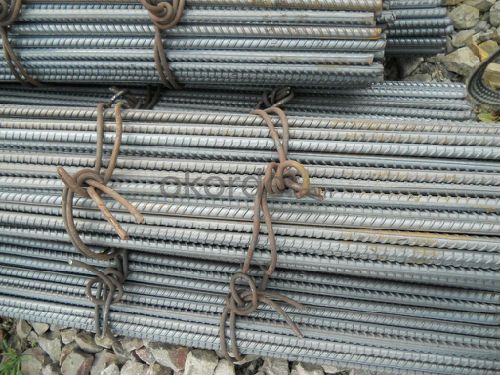
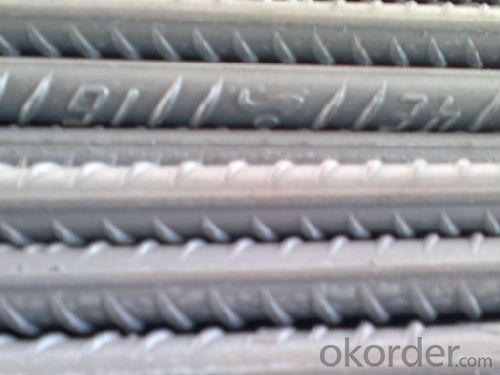
- Q: Are steel rebars suitable for use in wastewater treatment plants?
- Steel rebars are indeed a suitable option for utilization in wastewater treatment plants. The demanding and corrosive surroundings of these facilities often necessitate reinforced concrete structures. Fortunately, steel rebars, frequently employed for concrete reinforcement, provide the strength and durability required for such constructions. Their resistance to corrosion is particularly advantageous in wastewater treatment plants, where the presence of chemicals and corrosive elements is prevalent. Moreover, steel rebars offer exceptional tensile strength, guaranteeing that the concrete structures can endure substantial loads and pressures. All in all, steel rebars prove to be a dependable and suitable selection for incorporation in wastewater treatment plants, as they ensure the facility's longevity and structural integrity.
- Q: Why the longitudinal tie bar adopts screw steel bar, and the transverse transmission bar adopts light round steel bar.
- Steel is known as hot rolled ribbed bar. Ordinary hot rolled steel bars are made up of HRB and the minimum yield point of the brand. H, R, and B are the first letters in English for hot-rolled (Hotrolled), ribbed (Ribbed) and reinforced (Bars) three words. Hot rolled ribbed bar is divided into two levels, HRB335 (old No. 20MnSi), three HRB400 (20MnSiV, 20MnSiNb, old No. 20Mnti), four grade HRB500 three grade.
- Q: How do steel rebars affect the durability of concrete?
- The durability of concrete structures is greatly enhanced by steel rebars, as they play a crucial role in various aspects. Firstly, steel rebars increase the tensile strength of concrete. While concrete has impressive compressive strength, it lacks strength when it comes to tension. When external forces or loads are applied, concrete tends to crack and fail under tension. However, by embedding steel rebars within the concrete, the load is effectively distributed throughout the structure, preventing cracking and the propagation of cracks. This reinforcement allows the concrete to withstand greater tensile forces, thus improving its durability. Moreover, steel rebars assist in controlling the shrinkage and cracking of concrete. During the curing process, concrete shrinks due to water evaporation. This shrinkage can lead to the formation of cracks, compromising the structure's integrity. By incorporating steel rebars, the concrete is reinforced, restraining shrinkage and minimizing the occurrence and propagation of cracks. This ensures the durability of the concrete by maintaining its structural integrity. Furthermore, steel rebars have high resistance to corrosion. Concrete is generally alkaline, creating a protective layer on the surface of the steel rebars, preventing rusting or corrosion. This resistance to corrosion is crucial in maintaining the durability of concrete structures, especially in environments where they are exposed to moisture, chemicals, or other corrosive agents. The presence of steel rebars guarantees that the concrete remains structurally sound, preventing any potential weakening or deterioration due to corrosion. In conclusion, steel rebars have a significant impact on the durability of concrete structures. They enhance the tensile strength, control shrinkage and cracking, and provide resistance to corrosion. By reinforcing the concrete, steel rebars ensure that the structure can withstand external forces, maintain its structural integrity, and have a longer lifespan.
- Q: JL32 is the finish thread heavy bar 32? What's the difference between normal and ordinary? What does the front JL32 mean?
- Finishing rolling rebar diameter of JL32-- 32mm, 32 - screw steel hot rolled ribbed steel bars, the difference between the two: 1, ribbed bar is injected directly into the concrete, increase of steel concrete.
- Q: What are the standard sizes for steel rebars?
- The standard sizes for steel rebars vary depending on the country and industry standards. However, some common standard sizes for steel rebars include #3, #4, #5, #6, #7, #8, #9, #10, #11, #14, and #18. These numbers indicate the diameter of the rebar in inches. For example, a #3 rebar has a diameter of 3/8 inch, while a #18 rebar has a diameter of 2 1/4 inches. It is important to note that different countries may have their own unique sizing systems, so it is always necessary to consult the local building codes and standards for accurate information on steel rebar sizes.
- Q: Are there any safety concerns related to handling steel rebars?
- Yes, there are safety concerns related to handling steel rebars. Steel rebars are heavy and can cause strain or muscle injuries if not lifted properly. It is important to use proper lifting techniques and equipment such as gloves, back supports, and lifting tools to prevent injuries. Additionally, sharp edges on rebars can pose a puncture or laceration hazard, so it is crucial to wear appropriate protective clothing such as steel-toed boots and gloves. Workers should also be cautious of tripping hazards caused by rebars lying on the ground. Proper housekeeping and keeping the work area clear can help prevent accidents. Lastly, working with rebars involves the use of power tools such as cutting saws, which can generate noise, dust, and debris. Adequate hearing protection, dust masks, and eye protection should be worn to minimize these risks. Overall, following safety guidelines and proper procedures is crucial when handling steel rebars to prevent accidents and injuries.
- Q: What is the role of steel rebars in minimizing creep deformation in concrete?
- Steel rebars play a crucial role in minimizing creep deformation in concrete structures. Creep deformation refers to the gradual and permanent deformation that occurs in concrete over time under sustained loads. This phenomenon can lead to structural instability and compromise the overall integrity of the concrete. Steel rebars, also known as reinforcement bars, are embedded within the concrete matrix to provide additional strength and stiffness. These rebars help counteract the tensile forces exerted on the concrete, as concrete is weak in tension but strong in compression. By resisting the tensile stresses, the rebars prevent the concrete from cracking and experiencing excessive creep deformation. The presence of steel rebars in concrete also improves the load-carrying capacity of the structure, allowing it to bear heavier loads without excessive deformation. This is achieved by distributing the applied load more evenly throughout the concrete, reducing localized stress concentrations and minimizing the potential for creep deformation. Furthermore, steel rebars act as a restraining element, limiting the movement of the concrete and reducing the potential for creep. The high modulus of elasticity and low thermal expansion coefficient of steel make it an ideal material for reinforcing concrete and restraining its creep behavior. In summary, the role of steel rebars in minimizing creep deformation in concrete is multi-fold. They provide additional strength and stiffness to counteract tensile forces, improve load-carrying capacity, and act as a restraining element, all of which contribute to maintaining the structural integrity of the concrete over time.
- Q: What specifications should be used for the three - step steel electroslag pressure welding electrode?
- Steel is known as hot rolled ribbed bar. Ordinary hot rolled steel bars are made up of HRB and the minimum yield point of the brand. H, R, and B are the first letters in English for hot-rolled (Hotrolled), ribbed (Ribbed) and reinforced (Bars) three words. Hot rolled ribbed bar is divided into two levels, HRB335 (old No. 20MnSi), three HRB400 (20MnSiV, 20MnSiNb, old No. 20Mnti), four grade HRB500 three grade.
- Q: What are the different types of steel rebars used in industrial constructions?
- There are several different types of steel rebars that are commonly used in industrial constructions. These rebars are essential for reinforcing concrete structures and providing strength and durability to the overall construction. Some of the main types of steel rebars used in industrial constructions include: 1. Mild Steel Rebars: Also known as black steel rebars, these are the most commonly used type of rebars in construction. They are made from carbon steel and have a smooth surface. Mild steel rebars provide adequate strength and are cost-effective, making them suitable for a wide range of industrial applications. 2. High-strength Deformed Steel Rebars (HSD): These rebars have ribs or deformations on their surface to provide better bonding with concrete. HSD rebars are made from carbon steel and undergo a process called thermomechanical treatment to increase their strength. These rebars are commonly used in heavy-duty industrial constructions where higher strength is required. 3. Epoxy-coated Rebars: These rebars are coated with an epoxy resin to protect them from corrosion. Epoxy-coated rebars are commonly used in areas where the concrete is exposed to moisture or chemicals, such as bridges and marine structures. The epoxy coating acts as a barrier, preventing corrosion and extending the lifespan of the structure. 4. Galvanized Rebars: Galvanized rebars are coated with a layer of zinc to provide corrosion resistance. The zinc coating acts as a sacrificial layer, protecting the steel rebars from rusting. These rebars are commonly used in areas where the concrete is exposed to harsh environmental conditions or in coastal regions where the risk of corrosion is high. 5. Stainless Steel Rebars: Stainless steel rebars are highly corrosion-resistant and are used in environments that require exceptional durability and resistance to corrosion. They are commonly used in industrial constructions that are exposed to aggressive chemicals, high humidity, or extreme temperatures. Each type of steel rebar has its own set of advantages and is suitable for different applications based on the specific requirements of the industrial construction project. It is important to carefully consider factors such as strength, corrosion resistance, and cost when selecting the appropriate type of steel rebar for a particular construction project.
- Q: Are steel rebars suitable for reinforcement in residential buildings?
- Yes, steel rebars are suitable for reinforcement in residential buildings. Steel rebars provide excellent strength and durability, making them an ideal choice for reinforcing concrete structures in residential buildings. They help enhance the structural integrity of the building and ensure its long-term stability and safety.
Send your message to us
Hot Rolled Reinforcing Steel Bar
- Loading Port:
- China Main Port
- Payment Terms:
- TT or LC
- Min Order Qty:
- -
- Supply Capability:
- -
OKorder Service Pledge
OKorder Financial Service
Similar products
Hot products
Hot Searches
Related keywords
